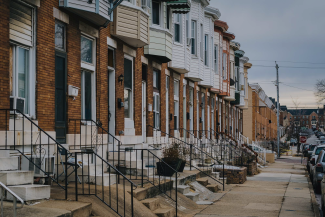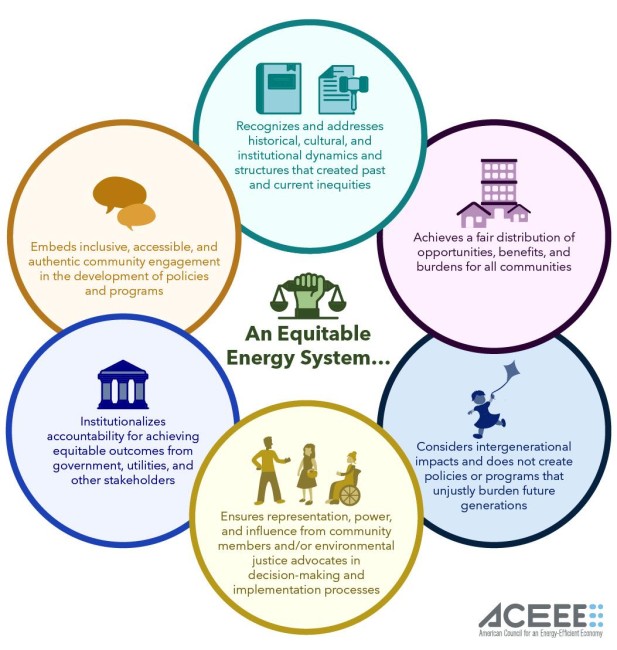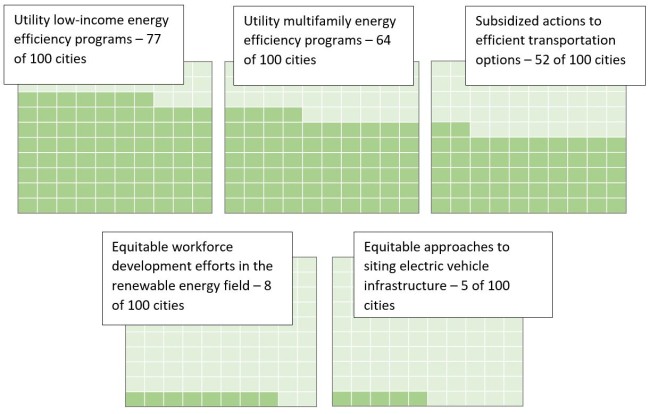This blog post is the first in a series taking a closer look at the findings of the 2021 City Clean Energy Scorecard.
Most cities are not doing enough to advance equity as part of their efforts to combat climate change, but cities such as Minneapolis and Chicago have started to take important steps and can serve as models for peers. In our 2021 City Clean Energy Scorecard, the 100 large cities we examined earned an average of only 15% of the points possible for equity-related actions, such as developing energy programs designed to reach communities of color and low-income residents.
Cities must work to improve the efficiency of all types of buildings—especially those housing communities of color and low-income families—to reach their climate goals and make energy more affordable. On top of bearing the brunt of climate impacts, these communities pay a disproportionate share of their incomes on energy bills, and often live in older homes that are poorly insulated and are not energy efficient. Furthermore, low-income communities and those with fewer resources are less able to improve the efficiency of the buildings they live and work in and adapt to the effects of climate change.
There are ample opportunities for cities to take an equitable approach that ensures all communities can access clean energy programs, that benefits are equitably distributed, and that cities meet their climate targets. As historical patterns of exclusion shape housing and workforce disparities everywhere, including in cities, clean energy efforts that don’t intentionally target equity will often exacerbate inequalities and can leave the most marginalized community members vulnerable. Several cities offer examples of practices that can guide cities in their work.
City Scorecard’s Approach to Gauging Equitable Clean Energy Action
In line with the increasing recognition of the importance of focusing on equity at all levels of government, we’ve added more equity-related metrics and increased the points cities can earn for taking equitable approaches. ACEEE’s approach to recognizing an equitable energy system is outlined in figure 1 below.
The 2021 City Scorecard includes 14 equity-related metrics for which cities could earn a total of 19 points. We measure actions taken by cities in several sectors, including activities like requiring equity assessments for city policies and budgets, providing support for owners of affordable housing to achieve energy performance standards, funding subsidized access to public transportation for low-income communities, and creating utility-administered energy efficiency programs for low-income customers.
Figure 1. Evaluating equitable approaches in the City Scorecard
Cities need to continue to move to outcome-based metrics to ensure accountability to equity. Therefore, the Scorecard includes both metrics that measure city processes and policies and metrics that measure outcomes. For example, cities are scored both on policies requiring affordable housing in transit-oriented developments and on the proportion of their low- and moderate-income residents with access to efficient public transportation.
City Scorecard Findings
A closer look at cities’ performances in individual equity metrics in the City Scorecard provides insight on areas of strength and weakness. Figure 2 highlights the three most frequently pursued equity actions in the City Scorecard, and two actions that were taken by few cities.
Figure 2. Frequency of equity-related actions in the City Scorecard
As figure 2 shows, many cities earned points for local utility offerings for low-income households and multifamily properties and for subsidizing access to efficient transportation options for low-income households. Other than these few metrics, fewer than 50 cities earned any credit for individual equity metrics in the Scorecard. For example, as seen above, only a handful of cities support equitable workforce development in the renewable energy sector or take equitable approaches to locating charging infrastructure for electric vehicles.
Cities have the most room for growth in actions that ensure decisions are made with a recognition of how benefits and harms are distributed in a community. Governments can pursue strategies to address energy inequities as well as the local government’s role in creating these disparities through past policies. They can do this through actions such as adopting comprehensive accountability procedures that analyze the impacts of policies and ensuring that affordable housing is included in development near transit.
Cities Show Leading Models
While all cities have a long way to go to reach their potential to advance equity in their energy work, we profile examples of strong approaches below. Cities can use these to inspire their own work, informed by their own context.
Baltimore requires evaluation of equitable outcomes
In 2018, responding to longstanding, institutionalized inequity in the city, Baltimore lawmakers passed legislation that requires “city agencies to assess existing and proposed policies and practices for disparate outcomes based on race, gender, or income and to proactively develop policies, practices, and investments to prevent and redress those disparate outcomes.” This ordinance requires a staff member in each agency to manage the agency’s participation in the Equity Assessment Program and institutes a requirement for consistent tracking. It also requires the city to conduct an equity assessment with each annual budget as well as an annual equity progress report.
Chicago connects communities to high-quality transit and supports workforce development
The City of Chicago supports a robust public transit system while incentivizing development and affordable housing near transit areas. Chicago’s zoning ordinance offers reduced minimum lot areas, increased height allowances, parking reductions, and other incentives for developers to build near transit.
The city also gives preference to projects located near public transportation when allocating affordable housing funds through its Qualified Allocation Plan process. This helps equitably distribute the benefits of transit to all segments of the community. As a result, using the Center for Neighborhood Technology’s AllTransit tool, ACEEE found that 92% of low-income households in the city have access to high-quality public transit.
Chicago also supports the equitable development of a local clean energy workforce through its PACE program. The program provides low-cost financing for commercial properties to take on clean energy projects. All projects over $2 million are required to meet minority- and women-owned business contracting goals.
Minneapolis directs clean energy work to marginalized areas and supports the creation of affordable passive housing
Minneapolis scored the highest on our City Scorecard equity-related metrics, earning 12 points out of a possible 19. The city takes an innovative approach to directing its clean energy work toward marginalized communities.
The Green Zones initiative identified two geographic areas in the city exposed to disproportionate environmental harm. Committees of residents from each zone then proposed actions that would bring about positive change and plans to build healthy and resilient communities. This approach allows the city to target environmental programming to areas of Minneapolis with the highest concentration of people in need of resources. The Minneapolis Clean Energy Partnership then tracks renewable energy and energy efficiency projects across the city and specifically measures progress in the Green Zones. Data on participation in energy efficiency programs is mapped in annual reports, with the Green Zones specifically outlined.
In addition, the city’s passive house programming in its vacant lot redevelopment assistance program provides funding for 6 to 12 new and affordable, highly energy-efficient homes to be built on vacant city lots, bringing the benefits of efficient and healthy housing to overlooked segments of the community.
Washington, DC, aims to ensure the efficiency of affordable housing without risking displacement of residents
The District of Columbia took a bold step to improve energy performance by requiring buildings to meet building energy performance standards. However, such standards require strategic attention to ensure that affordable housing owners are able to comply and that residents aren’t displaced. Therefore, the District developed the Affordable Housing Retrofit Accelerator to provide financial and technical support for building owners to comply.
The District of Columbia also connects communities to high-quality transportation by requiring affordable housing units to be included in development projects near public transit. Similarly, the District gives preference to projects near transit when considering affordable housing proposals.
By emulating these examples and taking bold action to center equity, cities can answer the call to ensure that all segments of the community are included in their transition to clean energy.





